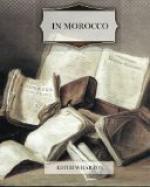A sense of the impending solemnity ran through the crowd. The mysterious rumour which is the Voice of the Bazaar rose about us like the wind in a palm-oasis; the Black Guard fired a salute from an adjoining hillock; the clouds of red dust flung up by wheeling horsemen thickened and then parted, and a white-robed rider sprang out from the tent of the Sacrifice with something red and dripping across his saddle-bow, and galloped away toward Rabat through the shouting. A little shiver ran over the group of occidental spectators, who knew that the dripping red thing was a sheep with its throat so skilfully slit that, if the omen were favourable, it would live on through the long race to Rabat and gasp out its agonized life on the tiles of the Mosque.
The Sacrifice of the Sheep, one of the four great Moslem rites, is simply the annual propitiatory offering made by every Mahometan head of a family, and by the Sultan as such. It is based not on a Koranic injunction, but on the “Souna” or record of the Prophet’s “custom” or usages, which forms an authoritative precedent in Moslem ritual. So far goes the Moslem exegesis. In reality, of course, the Moslem blood-sacrifice comes, by way of the Semitic ritual, from far beyond and behind it, and the belief that the Sultan’s prosperity for the coming year depends on the animal’s protracted agony seems to relate the ceremony to the dark magic so deeply rooted in the mysterious tribes peopling North Africa long ages before the first Phoenician prows had rounded its coast.
Between the Black Guard and the tents, five or six horses were being led up and down by muscular grooms in snowy tunics. They were handsome animals, as Moroccan horses go, and each of a different colour, and on the bay horse was a red saddle embroidered in gold, on the piebald a saddle of peach-colour and silver, on the chestnut, grass-green encrusted with seed-pearls, on the white mare purple housings, and orange velvet on the grey. The Sultan’s band had struck up a shrill hammering and twanging, the salute of the Black Guard continued at intervals, and the caparisoned steeds began to rear and snort and drag back from the cruel Arab bits with their exquisite niello incrustations. Some one whispered that these were His Majesty’s horses—and that it was never known till he appeared which one he would mount.
Presently the crowd about the tents thickened, and when it divided again there emerged from it a grey horse bearing a motionless figure swathed in blinding white. Marching at the horse’s bridle, lean brown grooms in white tunics rhythmically waved long strips of white linen to keep off the flies from the Imperial Presence, and beside the motionless rider, in a line with his horse’s flank, rode the Imperial Parasol-bearer, who held above the sovereign’s head a great sunshade of bright green velvet. Slowly the grey horse advanced a few yards before the tent; behind rode the court dignitaries, followed by the musicians, who looked, in their bright scant caftans, like the slender music-making angels of a Florentine fresco.




